Contaflex (SLR)
Contents
- 1 Introduction
- 2 Contaflex I and II
- 3 Contaflex III and IV
- 4 Contaflex Alpha and Beta
- 5 Contaflex Rapid and Super
- 6 Contaflex Prima
- 7 Contaflex's exchangeable back
- 8 Contaflex Super (new) and Super B
- 9 Contaflex Super BC and S
- 10 Contaflex lenses
- 11 Contaflex 126
- 12 Weber SL75
- 13 Notes
- 14 Bibliography
- 15 Links

|
| brochure cover "Lady with Contaflex II", and Contaflex Prima w/ wide-angle lens image by alex "Heimatland" analog ≙ (Image rights) |
Introduction
The Contaflex family of 35mm leaf-shuttered SLR cameras was introduced in 1953 by Zeiss Ikon, utilising the newly developed Compur reflex shutter. By doing so, a completely new 35mm camera emerged, a concept probably first used in 1929 in the Mentor Compur-Reflex. The Contaflex name was made famous and became highly respected due to the spectacular 35mm twin lens reflex Contaflex, introduced in 1935 and only produced a few years.
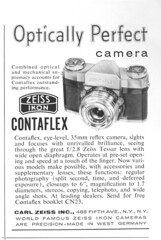
|
| Contaflex ad in National Geographic, January 1958 (Image rights) |
The Zeiss Ikon AG factory in Dresden was almost totally eradicated by the end of World War II. The remains were gathered in Stuttgart, then in West Germany. Only a few prototypes were rescued. Both the lens- and most of the camera production had to be rebuilt from scratch. This was at the same time a tremendous opportunity for the company to develop completely new products. In this situation, ZI was in desperate need for new cameras models. Yet, it should be remembered that almost all the popular cameras manufactured worldwide, have their origins in Germany; these are typically the 6x6 TLR 1928 Rolleiflex, the 1925 Leica and the 1932 Contax 35mm rangefinder cameras, as well as the 1936 Kine Exakta and the 1949 Contax S 35mm SLR cameras.
This was the situation when ZI started designing the Contaflex SLR camera. Zeiss had already developed the pentaprism viewing system in the late 1930s, and being convinced the compact, reliable and easily manufactured leaf shutter could outperform the focal plane shutter, they set out building a compact high quality camera for the masses.
The result was the first 35mm SLR camera equipped with a between-the-lens leaf shutter. Such an arrangement requires the shutter to stay open before the picture is taken, in order to see through the reflex finder. This in consequence, requires a second shutter behind the mirror to stay closed. When the release button is depressed, a series of events must take place very fast: Close the lens shutter, reduce the lens aperture to the preset f-stop, raise the reflex mirror and open auxiliary shutter. Then the exposure can take place by opening and closing the lens shutter. Note that the shutter moves three times. In later models it was also required to open again at the end of the sequence to restore the viewfinder image, and eventually one would also have wished for the lens aperture to open fully again. This is a very complex cycle of operations to accomplish satisfactorily and reliably.
However, the advantages are a compact camera and flash synchronisation at all shutter speeds. The limited number of lenses possible to combine with the shutter, and the mechanical complexity involved, was not considered a great disadvantage. Most amateur photographers at the time would seldom, or not at all, buy an extra lens for their cameras. The complexity would probably be considered more like a challenge than a problem. In the final form, however, no Contaflex model ever acquired a rapid return mirror, and as expected, only a limited range of extra lenses was available, from 35mm to 115mm focal length, deemed sufficient for the advanced amateur. Eventually these shortcomings would be fatal for the concept.
The Contaflex family actually was quite successful, quite reliable and performed well, and large number of improved models and new ranges of lenses were introduced all the way up until Zeiss Ikon itself was closed down.
Soon enough cameras along the same lines emerged, actually, the Mecaflex was launched in 1953 too, but although a leaf shuttered 35mm SLR camera, it did not have an eyelevel pentaprism viewfinder. Next was the similarly designed Tokiwa Seiki Firstflex from 1955. True copies was not seen until the Kodak Nagel Werke launched their Kodak Retina Reflex in 1956, followed by the Voigtländer Bessamatic in 1959 with pentaprism viewfinders. Others, like Agfa, Pentacon and many Japanese makers, would follow. However, the complexity of the mechanical design required precision and quality materials, and most of the other models are not reputed for reliability, while the Contaflex, Retina Reflex and Bessamatic performed satisfactorily and sold in quantities.
Contaflex I and II
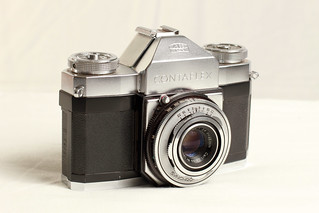
|
| Contaflex I image by Lightshaper (Image rights) |
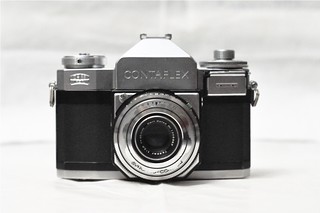
|
| Contaflex II image by Antonio Carlos Castejón (Image rights) |
The Contaflex I, launched in 1953, was equipped with a fixed Zeiss Tessar 45mm f:2.8 lens with front-cell focusing. The very first Contaflex I had a Synchro-Compur shutter with the old scale of shutter speeds (1-2-5-10-20-50-100-250-500), but very soon it adopted the new scale 1-2-4-8-15-30-60-125-250-500.
The Contaflex II, introduced the following year, was the same camera with an uncoupled selenium meter added to one side of the front plate.
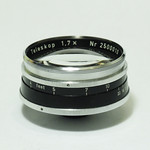
|
| Zeiss Teleskop 1.7x image by PF McFarland (Image rights) |

|
| Teleskop 1.7x with mounting bracket on a Contaflex II image by PF McFarland (Image rights) |
The Contaflex I and II have fixed lenses although it is possible to add a 1.7x supplementary lens (called the Teleskop 1.7x) using an adapter mount (861/07). The adapter mount slides on to the camera body below the lens and locks into place using a pair of hinged lugs. The Teleskop 1.7x lens screws on to the adapter mount and also locks into place. Interestingly the lens-to-subject focus distance remains almost the same with the use of the Teleskop 1.7x and effectively increases subject magnification. Note that the adapter mount cannot be attached if a filter is fitted to the fixed lens.
Contaflex III and IV
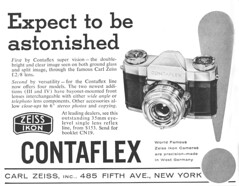
|
| Contaflex III/IV ad in National Geographic, May 1957 (Image rights) |
The Contaflex III, launched in 1956, was the same as the I, but equipped with a Zeiss Tessar 50mm f:2.8 with helical focusing. The front element of the lens was removable and could be replaced by supplementary lenses, discussed in the section Contaflex lenses.
The Contaflex IV, introduced the same year, was the same camera with the uncoupled meter inherited from the Contaflex II.
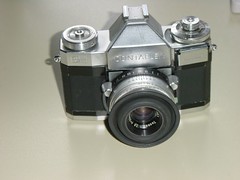
|
| Contaflex IV image by mikeasaurus (Image rights) |
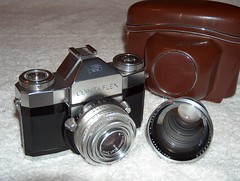
|
| Contaflex III image by Gerard Vogels (Image rights) |
Contaflex Alpha and Beta

|
Contaflex Alpha image by John-Henry Collinson (Image rights) |
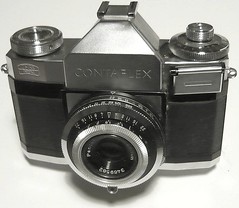
|
| Contaflex Beta image by gianlukalta (Image rights) |
The Contaflex Alpha and Contaflex Beta, both introduced in 1957, were based on the same body but equipped with a Zeiss Pantar 45mm f:2.8 three-element lens and a Prontor Reflex shutter up to 1/300. They were the cheaper models of the line. The Alpha had no meter and the Beta had the selenium meter of the II and IV.
The front element of the lens could be interchanged with others for 30mm f:4 and 75mm f:4. These could also be used on the Contina III 35mm viewfinder camera.
Contaflex Rapid and Super
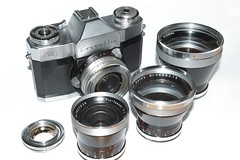
|
| Rapid image by John F Richardson (Image rights) |
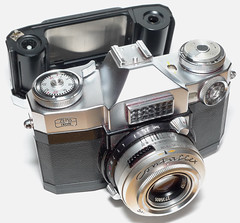
|
| 1960 Contaflex Super image by Howard Somerville (Image rights) |
The Contaflex Rapid was introduced in 1958 and had a slightly longer body, a built-in accessory shoe, a winding lever and a rewind crank. It was the meterless version.
The Contaflex Super (not to be confused with later models of the same name), launched the following year, was based on the Rapid and had a coupled selenium exposure meter on the front side of the prism. It is easily recognized by the aperture setting wheel on the front plate.
The Contaflex Super has a relatively unique control set designed to streamline finding the correct exposure. The shutter speed ring is at the far front (as the Synchro-Compur is, as always, a rimset shutter), and it is geared to the aperture ring, which is immediately behind it, and which cannot be turned by hand. When the shutter speed ring, with its large grips, is rotated, the aperture ring, to the extent that this is possible, will rotate in the opposite direction, so as to maintain the same exposure value for any given shutter speed. This constant-EV mechanism in itself was not unusual in the late 50's, though on this camera it forms part of a convenient metered exposure system that is probably unique to this camera.
To wit, the aperture can be controlled separately by rotating the fingerwheel at the upper right, which is coaxial with the film speed setting dial. This is connected directly to the meter, such that by adjusting this fingerwheel, the needle can quickly be centered, yielding correct exposure. There are two such needles, one in a window on top of the camera, and one behind a translucent window on the front of the camera next to the fingerwheel, with a mirror allowing it to be seen inside the viewfinder next to the focusing screen. (This leads to the unique situation where the needle window remains lit when the viewfinder goes dark during and after exposure.) The top needle display has a circle showing correct exposure, while the viewfinder display has a notch-shaped cutout for the same purposes.
The Rapid and Super could take the same supplementary lenses as the III and IV. The cameras had also the same focusing concept, with two extra grips on the focusing ring which moves the whole lens forwards and backward when turned.
Contaflex Prima
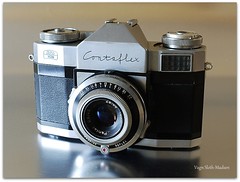
|
| image by Vagn Sloth-Madsen (Image rights) |
The Contaflex Prima, launched in 1959 and sold until 1965, was based on the body of the Rapid, but with the Pantar lenses and the Prontor shutter like the Alpha and Beta. The Prima had a coupled exposure meter placed on the side of the front plate, different from that of the Super.
The Prima could take the Pantar supplementary lenses like the Alpha and Beta.
Contaflex's exchangeable back
An alternate camera back was offered by Zeiss Ikon, a camera back that fit for some Rapid, early Super and Prima models. The 35mm film had to be loaded into the film back which held the film capsule itself light tight, as well as the take-up reel. Even the image plane could be covered light tight with a removable sliding door so that the whole film back could be removed mid-roll and exchanged by another loaded film back. This made the cameras attractive for ambitious tourists who wanted to use one fine camera for both slide films and negative films.
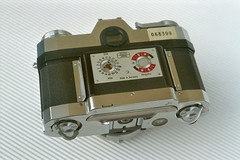
|
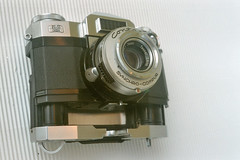
|

|
| releasing the back by turning the counter-sunk release-knobs with the hinged bugle grips |
pulling out the back | feeding in the film |
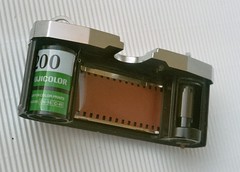
|
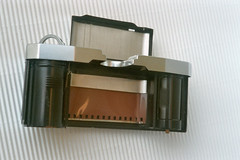
|
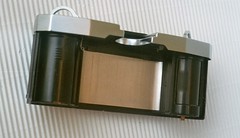
|
| the film is loaded | closing film roll chambers, and even the focal plane |
light tight film back ready for usage images by Uwe Kulick (Image rights) |
Contaflex Super (new) and Super B
The Contaflex Super (new) and Contaflex Super B are very similar cameras. Both have a new body design, both longer and more bulky. The information about which came first is a bit contradictory in some reference books, but it seems the Super (new) was launched in 1962, introducing the new body design and a new selenium exposure meter in a prominent rectangle marked Zeiss Ikon in front of the prism. The aperture wheel was replaced by a more traditional aperture ring, and the meter read-out was visible both on the exterior and in the finder.
The Super B was launched in 1963, and added a shutter-priority automatic aperture, and maybe some other small changes.
The new body of the Super (new) and Super B allowed to take magazine backs, interchangeable with a partly exposed film inside. But of course the new film backs were wider as the redesigned cameras were. (Magazine backs, rare among 35mm cameras, were also supplied for the Zeiss Ikon Contarex.)
From the Super (new) and Super B, the Zeiss Tessar 50mm f:2.8 lens was recomputed and supposedly performed better. They could still take the same supplementary lenses, with one exception discussed in the relevant section.
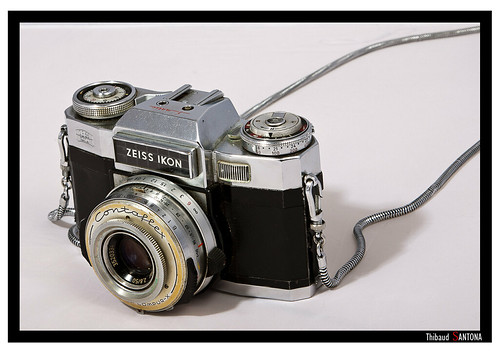
|
| image by Maestr!0_0! (Image rights) |

|
| Contaflex Super B w/o echangeable back image by Peter Lerman (Image rights) |
Contaflex Super BC and S
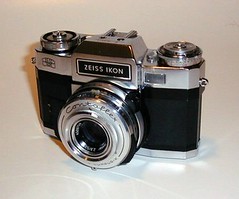
|
| Contaflex Super BC image by Bill Strong (Image rights) |
The Contaflex Super BC was introduced in 1965, and was a Super B with the selenium meter replaced by a CdS through-the-lens exposure meter. It still had a black rectangle marked Zeiss Ikon on the front of the prism, but it was only decorative. It had a battery compartment at the bottom front.
The Contaflex S was the last variant, introduced in 1968, and was simply a renamed Super BC. It had a black rectangle marked Contaflex S on the front, and a different, newer Zeiss Ikon logo. It proudly sported the word Automatic on the front of the shutter.
The Super BC and S could take the magazine backs, as well as the usual supplementary lenses.
Both the Contaflex Super BC and S were sold in chrome or black; they were the only Contaflex models to be produced in black.
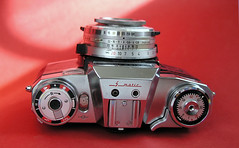
|
| image by Jim.jpg (Image rights) |

|
| Contaflex S - black finish image by Geoff Harrisson (Image rights) |
Contaflex lenses
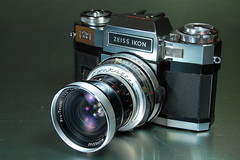
|
| with Pro-Tessar 35mm f/3.2 image by Raúl Sá Dantas (Image rights) |
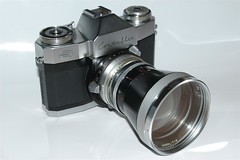
|
| with Pro-Tessar 115mm f/4 image by John F Richardson (Image rights) |
We have already seen that the Contaflex I and II could only take the Teleskop 1.7x supplementary lenses, and that the Alpha, Beta and Prima had their own limited range of Pantar supplementary lenses.
The models III, IV, Rapid, Super, Super (new), Super B, Super BC and S all have a Zeiss Tessar 50mm f:2.8 lens (27mm screw-in or 28.5mm push-on filters) with interchangeable front elements tube. All of them can take a small range of alternate front elements tube (convertible lens concept):
- Zeiss Pro-Tessar 35/4 (49mm filters), later replaced by the Pro-Tessar 35/3.2 (60mm screw-over filters)
- Zeiss Pro-Tessar 85/4 (60mm screw-over filters), later replaced by the Pro-Tessar 85/3.2 (60mm filters)
- Zeiss Pro-Tessar 115/4 (67mm filters), closest focusing distance: approximately 2,95 meters
- Monocular 8x30B, equivalent to a 400mm lens (attaches to the 50mm f/2.8 Tessar lens).
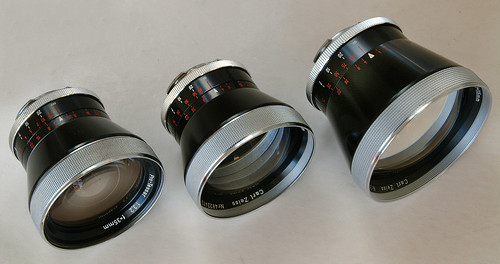
|
| Pro Tessar lenses 35mm, 85mm, 115mm image by Geoff Harrisson (Image rights) |
There was also a Zeiss Pro-Tessar M 1:1 supplementary lens, that kept the focal length of 50mm but allowed 1:1 reproduction. The effective speed of the M 1:1 lens is f/5.6. The 50mm standard front elements, as well as the Pro-Tessar M 1:1 elements, were different between the early models III, IV, Rapid and Super with the old model of Tessar, and the later models Super (new), Super B, Super BC and S with the recomputed Tessar. It appears that the mount was very slightly modified, and it seems physically impossible to mismatch the elements as the journal diameter above the bayonet mount had been reduced by approximately .006"
Stereo
There were also stereo attachments that were used by mounting them as front lens units:
- Steritar A for the Contaflex I and II which needs a bracket for mounting [1]
- Steritar B for the other Tessar-equipped models
- Near Steritar for close up stereo pictures .2 - 2.5 meters
(Normally interchangeable with the older Tessar line of Steritar B camera lenses)
- Steritar D for the Pantar-equipped models
A complete line of these Contaflex Steritar lenses can be seen in these photos from widgits on Flickr.
Contaflex 126
The Contaflex 126 is a completely different body. Its only relation to the rest of the Contaflex family is its name. It was introduced in 1967 to accept Kodak 126 (Instamatic) cartridges. It was one of only five SLRs taking 126 film, the others were: Rolleiflex SL26, Kodak Instamatic Reflex, Keystone K 1020 SLR Auto-Instant Reflex, Ricoh 126c-Flex TLS.[2]
The Contaflex 126 is a SLR with a focal-plane shutter and interchangeable lenses. The range of lenses was:
- Zeiss Distagon 25/4
- Zeiss Distagon 32/2.8
- Zeiss Pantar 45/2.8, three-element, cheaper
- Zeiss Tessar 45/2.8, four-element, better
- Zeiss Sonnar 85/2.8
- Zeiss Tele-Tessar 135/4
- Zeiss Tele-Tessar 200/4
The Contaflex 126 lenses are often confused with other lenses by the sellers. They can only be used on the Contaflex 126 body, that can only take the obsolete 126 cartridge, so the value of these lenses is not very high, despite their famous names.
Weber SL75
When Zeiss Ikon stopped making cameras in 1972, they had prototypes in various stages of development. One of them was the SL725, which would be a successor to the Contaflex line with an electronic shutter. The prototype ended in the hands of a company named Weber, which presented the camera at a Photokina show under the name Weber SL75 could not afford to put it into production, and did not find a partner to do so. The lens mount was a modification of the Contarex mount. Carl Zeiss advertised a range of lenses for the Weber SL75, all with the T* multicoating:[3]
- 18/4 Distagon
- 25/2.8 Distagon
- 35/2.8 Distagon
- 50/1.4 Planar
- 85/2.8 Sonnar
- 135/2.8 Sonnar
- 200/3.5 Tele-Tessar
An eBay seller seems to have uncovered a small stock of the Planar lens, and has recently sold a couple of them. No SL75 body seems to have surfaced so far, and the only picture found on the web is here.
Notes
- ↑ Steritar A at Pacific Rim Camera
- ↑ Comparison of all five 126 SLR on KniPPsen
- ↑ Source: Zeiss prospectus from 1974.
Bibliography
- Barringer, C. and Small, M. Zeiss Compendium East and West — 1940–1972. Small Dole, UK: Hove Books, 1999 (2nd edition). ISBN 1-874707-24-3.
Links
In English :
- Contaflex IV Repair in Classic Cameras by RaúlM.
- Contaflex Super BC in Classic Cameras by RaúlM.
- Zeiss Ikon/Contaflex instruction manuals (15 models) English - German - French at Butkus.org
- Contaflex Camera Manuals (PDF) : Photo-Manuals.com
- Interchangeable Backs and the Contaflex S article by Geoff Harrisson
- Contaflex 126 on KniPPsen
- Pantar Convertible Lenses at Butkus' OrphanCameras.com
- Steritar A, B and D Instructions at Pacific Rim Camera Zeiss Pages
- Zeiss Ikon Contaflex at Pacific Rim Camera Zeiss Pages
In French :
- Pages at www.collection-appareils.com by Sylvain Halgand
- Contaflex 126
- Contaflex I
- Contaflex II
- Contaflex IV
- Contaflex super
- Contaflex super B
- Contaflex III Mode d'emploi at www.OrphanCameras.com
- Zeiss Ikon Contaflex mode d'emploi at www.OrphanCameras.com
In German:
In Japanese:
| Zeiss Ikon Classic Cameras |
|---|
| Contax | Contaflex (TLR) | Super Nettel | Nettax | Tenax II | Tenax I | Ikoflex | Super Ikonta
Contax S | Contaflex (SLR) | Contarex | Icarex | SL706 |